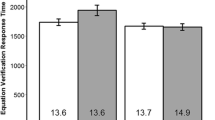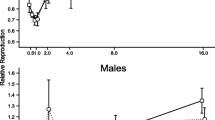Abstract
We report two experiments demonstrating temporal binding between action and outcome (Haggard et al. 2002a) as measured in a temporal reproduction paradigm. Our results show that the effect is empirically robust, does not rely on repeated presentation of fixed intervals, truly affects time perception, and persists across intervals much longer than in earlier demonstrations with the Libet Clock paradigm (Libet et al. 1983).

Similar content being viewed by others
References
Buehner MJ, Humphreys GR (2009) Causal binding of actions to their effects. Psychol Sci 20(1):1221–1228
Buehner MJ, Humphreys GR (2010) Causal contraction: spatial binding in the perception of collision events. Psychol Sci 21(1):44–48
Buehner MJ, May J (2002) Knowledge mediates the timeframe of covariation assessment in human causal induction. Think Reason 8(4):269–295
Cohen J, Macwhinney B, Flatt M, Provost J (1993) Psyscope—an interactive graphic system for designing and controlling experiments in the psychology laboratory using Macintosh computers. Behav Res Methods Instrum Comput 25(2):257–271
Cunningham DW, Billock VA, Tsou BH (2001) Sensorimotor adaptation to violations of temporal contiguity. Psychol Sci 12(6):532–535
Danquah AN, Farrell MJ, O’Boyle DJ et al (2008) Biases in the subjective timing of perceptual events: Libet et al. (1983) revisited. Conscious Cogn 17(3):616–627
Engbert K, Wohlschläger A, Haggard P (2008) Who is causing what? The sense of agency is relational and efferent-triggered. Cognition 107(2):693–704
Gibbon J, Church RM, Meck WH (1984) Scalar timing in memory. Ann N Y Acad Sci 423(MAY):52–77
Haggard P, Aschersleben G, Gehrke J, Prinz W (2002a) Action, binding, and awareness. In: Prinz W, Hommel B (eds) Common mechanisms in perception and action: Attention and performance, vol. XIX. Oxford University Press, Oxford, pp 226–285
Haggard P, Clark S, Kalogeras J (2002b) Voluntary action and conscious awareness. Nat Neurosci 5(4):382–385
Humphreys GR, Buehner MJ (2009) Magnitude estimation reveals temporal binding at super-second intervals. J Exp Psychol Hum Percept Perform 35(5):1542–1549
Kennedy JS, Buehner MJ, Rushton SK (2009) Adaptation to sensory-motor temporal misalignment: instrumental or perceptual learning? Q J Exp Psychol 62(3):453–469
Libet B, Gleason CA, Wright EW, Pearl DK (1983) Time of conscious intention to act in relation to onset of cerebral-activity (Readiness-Potential)—the unconscious initiation of a freely voluntary act. Brain 106(SEP):623–642
Stetson C, Cui X, Montague PR, Eagleman DM (2006) Motor-sensory recalibration leads to an illusory reversal of action and sensation. Neuron 51:651–659
Wearden JH (2006) Mission (almost) impossible: modelling the verbal estimation of duration. In: Paper presented at the Birmingham meeting of the experimental psychology society
Wearden JH (2008) Slowing down an internal clock: implications for accounts of performance on four timing tasks. Q J Exp Psychol 61(2):263–274
Wearden JH, O’Rourke SC, Matchwitck C, Min Z, Maeers S (2010) Task switching and subjective duration. Q J Exp Psychol (in press). doi:10.1080/17470210903024768
Wegner DM (2002) The illusion of conscious will. MIT Press, Cambridge
Wenke D, Haggard P (2009) How voluntary actions modulate time perception. Exp Brain Res 196(3):311–318
Wohlschläger A, Engbert K, Haggard P (2003a) Intentionality as a constituting condition for the own self-and other selves. Conscious Cogn 12(4):708–716
Wohlschläger A, Haggard P, Gesierich B, Prinz W (2003b) The perceived onset time of self- and other-generated actions. Psychol Sci 14(6):586–591
Wolpert DM (1997) Internal models in human motor control: a computational and psychophysical perspective. J Physiol-Lond 501P:S12–S12
Zakay D, Block RA (1997) Temporal cognition. Curr Dir Psychol Sci 6(1):12–16
Acknowledgments
This research was funded by Engineering and Physical Research Council grant EP/C000444691/1, awarded to MJB.
Author information
Authors and Affiliations
Corresponding author
Rights and permissions
About this article
Cite this article
Humphreys, G.R., Buehner, M.J. Temporal binding of action and effect in interval reproduction. Exp Brain Res 203, 465–470 (2010). https://doi.org/10.1007/s00221-010-2199-1
Received:
Accepted:
Published:
Issue Date:
DOI: https://doi.org/10.1007/s00221-010-2199-1




